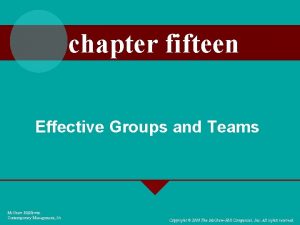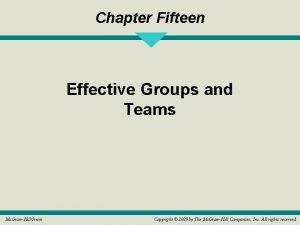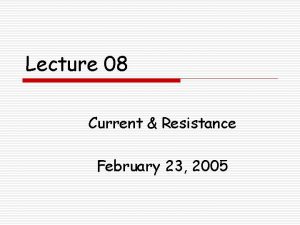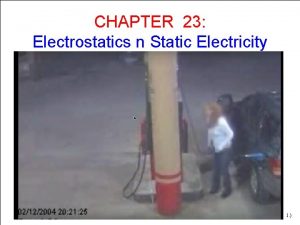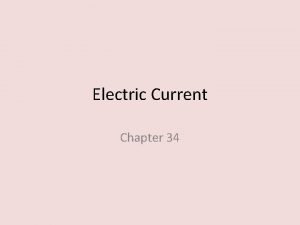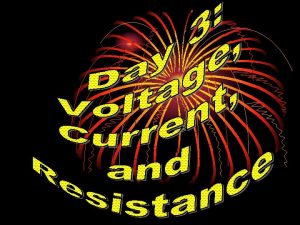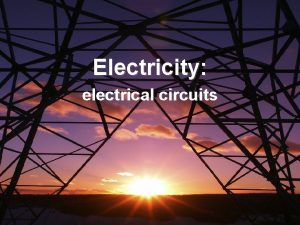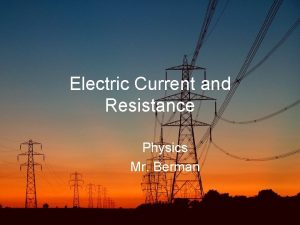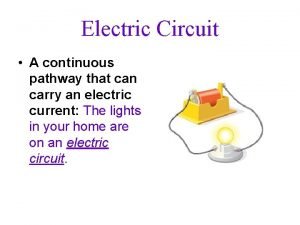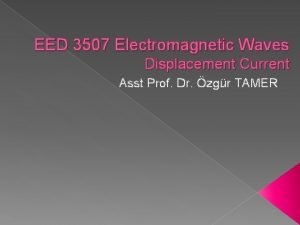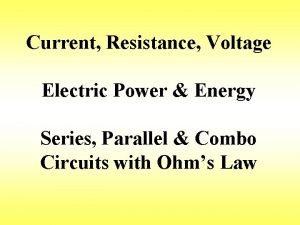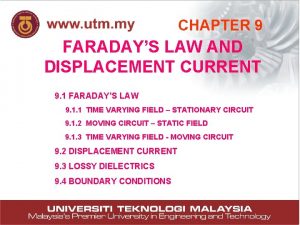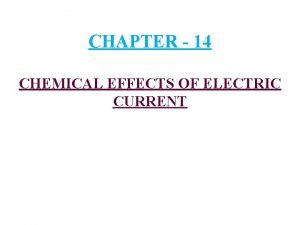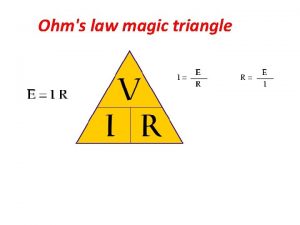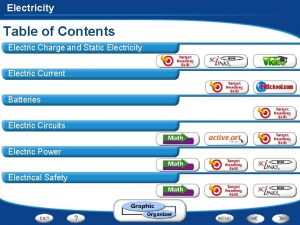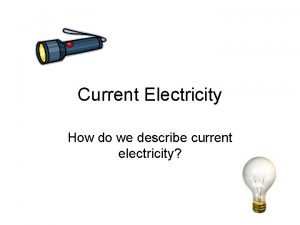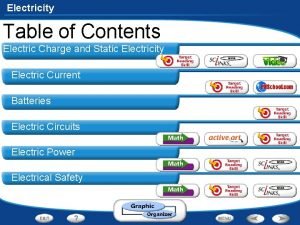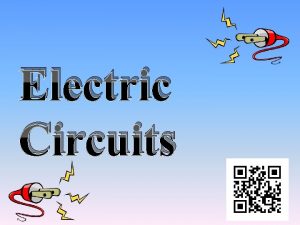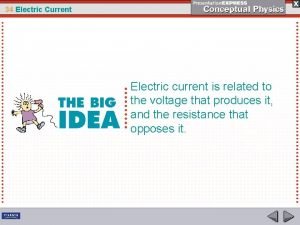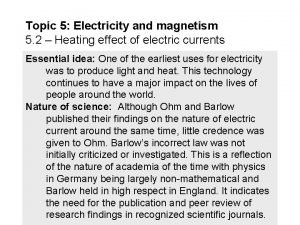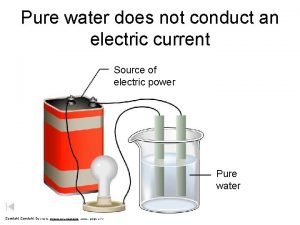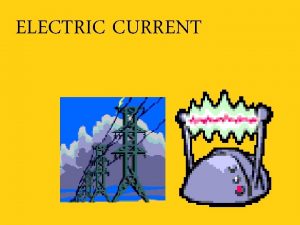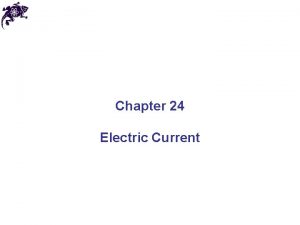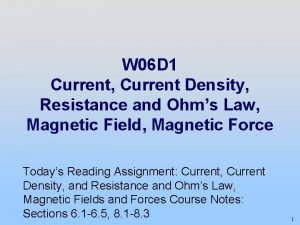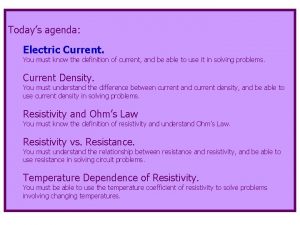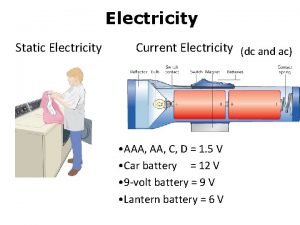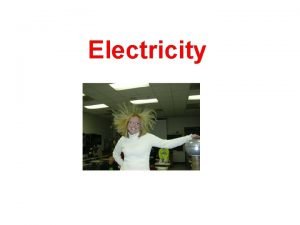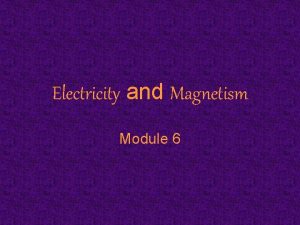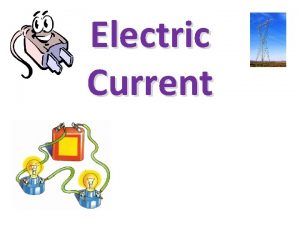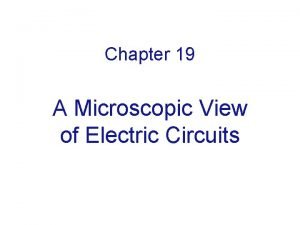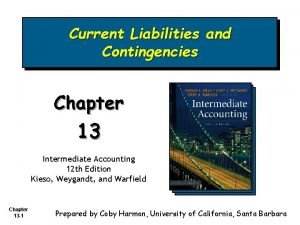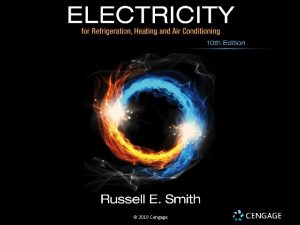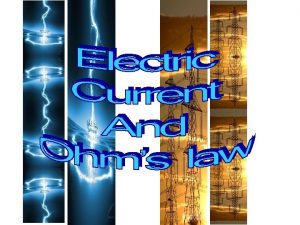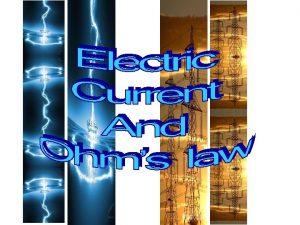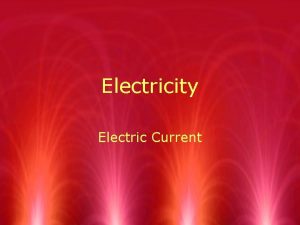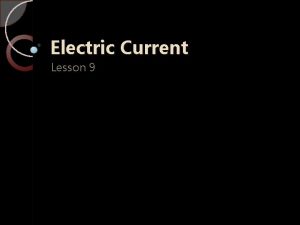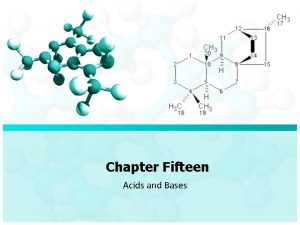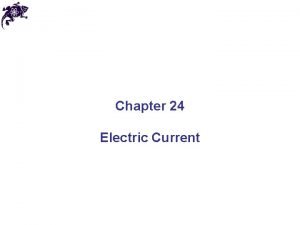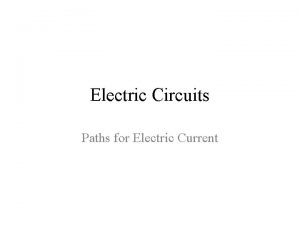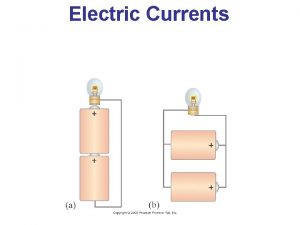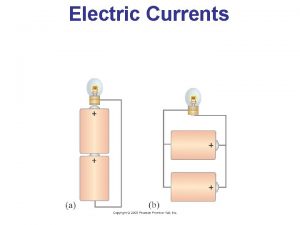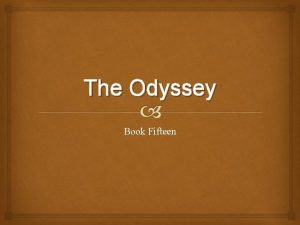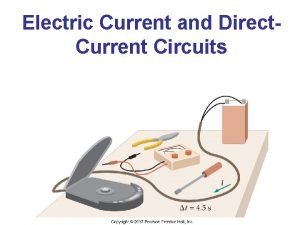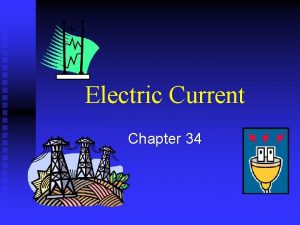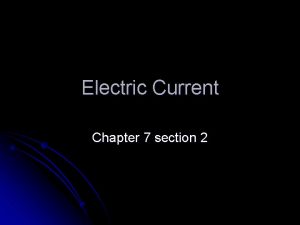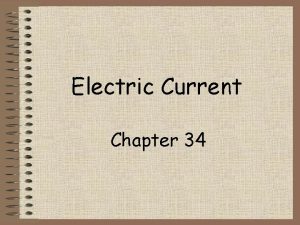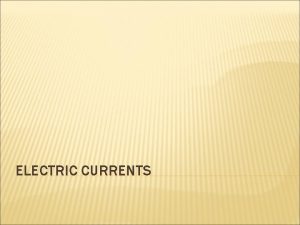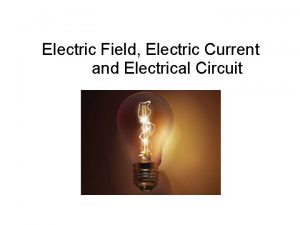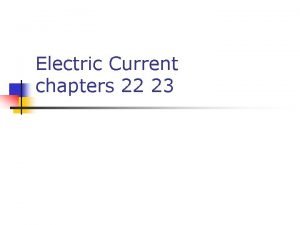Chapter Fifteen Electric Current 1 Electric Current We











































































- Slides: 75

Chapter Fifteen Electric Current 1

Electric Current • We consider the motion of electrons in a conductor (a metal) when there is a voltage difference applied between the ends of the conductor. • We will limit our discussion mostly to direct currents, that is, currents whose magnitude and direction do not change with time. 2

Motion of Charges in an Electric Field • By Newton's second law F = ma we have where q represents an arbitrary charge. 3

• In the case of an electron, the mass of an electron is and Thus • We may calculate the velocity of the electrons after they travel a distance s assuming that no scattering (or collisions) occurs over that distance. • When velocity is and , the 4

Electric Current • The motion of an electron in an electric field is a series of short accelerations interrupted by collisions that scatter the electron. It has a random path, although there is a slow net velocity opposite to the field direction (see Fig. 15 -1). It is the net velocity of the electrons, called the drift velocity, that gives rise to the current, not the brief accelerations. 5


• The charge that flows by in time through a plane perpendicular to a wire is defined as electric current i, where • When i is not constant we define electric current as 7

• In the SI units, current is measured in amperes, or amps. One ampere (1 A) is equal to one coulomb per second and is a relatively large quantity. • We use the milliampere (1 m. A = 10 -3 A) or the microampere (1 μA = 10 -6 A). 8

• See Fig. 15 -2. Assume that there are both positive and negative charges, both of which are mobile in the presence of an electric field with a vector direction from left to right. Assume that there are Np (Nn) positive (negative) charges per unit volume with drift velocity of vp (vn). 9


• In time the positive charges will move from left to right a distance of. If each charge has a charge qp, the charge flowing across the right end of the cylinder is Thus, 11

• In the same way, the negative particles, each with charge qn, flow from right to left given rise to a current • Both the sign of the charge qn and the sign of the drift velocity vn are negative and therefore their product is positive. 12

• A flow of negative charges to the left is equivalent to a flow of positive charges to the right. Thus, • The direct current i in a conductor has the same direction as that of the electric field. 13

• There is no pileup of electric charges in the wire at any point. If we connect a wire between the terminals of a battery, it is therefore reasonable to conclude that charge flows at a steady rate throughout the wire. • The current density is defined as the current per unit cross-sectional area, that is 14

Example 15 -1 • Suppose a copper wire carries 10 A (amps) of current and has a cross-section of 10 -6 m 2. As will be seen later, each atom of copper contributes one electron that is free to move, so the electron carrier density Nn is about the same as the density of atoms, which is about 7 × 1028 atoms per m 3. The charge on an electron is -1. 6 × 10 -19 C. (a) What is the drift velocity vn of the electrons? (b) How long would it take an electron to move from one terminal of a battery to the other if this wire were 1 m long? 15

Sol • (a) • (b) So the actual drift velocity of a given electron is very small. The speed of propagation of the electric field along the wire is that of the speed of light in the wire. 16

Resistance and Resistivity • Experiment shows that in many cases the electric current i, hence the current density J , are proportional to E. . • Define electrical resistivity ρ as • The resistivity is a property of a given material and is independent of its shape. 17

• The resistivity was found to be a constant for a given metal at a given temperature by G. Ohm. Thus, the above equation is called Ohm's law. • A material obeying Ohm's law is called an ohmic conductor. • The units of ρ( called ohm meter, Ω-m) is • See Table 15 -1 18

• The conductivity σ is defined as • Suppose we have a given metal wire with cross section A, length l, and resistivity ρ with an applied electric field (see Fig. 153). The potential difference between the two ends of the conductor, point 1 and 2 is 19


• If the electric field inside the conductor is uniform, where l = s 2 - s 1. Thus, which can be written as where V means and • R is called resistance of the wire and has units of Ω (ohms). • The current in a resistance (resistor) is from its high potential side to its low potential side. 21

Resistances in Series and Parallel • See Fig. 15 -4. The voltage difference across a resistance (resistor) is called voltage drop. • See Fig. 15 -5. The electric potential at point A is the same as that at the left side of the battery (emf), and that at point D is the same as the right side of the battery. The same current must pass through each of these resistances at that which passes between points A and D. This combination is called series resistances. 22


where Req is the equivalent resistance of the three. • It is obvious that will be true regardless of the number of resistances in series. • See Fig. 15 -6. The resistances is arranged in parallel. 24


• The left side of each resistance is at the same potential and the right side is at the same potential, hence, the same voltage drop V must occur across each. • . By Ohm's law, • and 26

• Thus, where 27

• See Fig. 15 -9. The current through R 1 is the same as that through R 2, and • where V 1 and V 2 are the voltage drops across R 1 and R 2, respectively. Equating the i's gives 28


• In a series circuit the ratio of the voltage drops is equal to the ratio of the resistances. • See Fig. 15 -10. The voltage across each resistance is the same and • Equating V 1 and V 2 gives 30


• In a parallel circuit the ration of the currents through each resistor is inversely proportional to the resistances. 32

Example 15 -2 • Suppose in Fig. 15 -5 the voltage V = 1. 5 V and the resistances are R 1 = 5 Ω; R 2 = 10 Ω, and R 3 = 15 Ω. What are the voltages VAB, VBC, and VCD? 33

34


Sol • Then applying Ohm's law to each resistance 36

Example 15 -3 • Suppose two resistors, R 1 = 5 Ω and R 2 = 10 Ω, are connected in parallel to a 1. 5 V battery as in Fig. 15 -7. (a) What is the current through each? (b) What is the total current in the circuit? 37


Sol • (a) Using Ohm's law • (b) i = i 1 + i 2 = 300 m. A + 150 m. A = 450 m. A. We may check this answer by solving the equivalent circuit. 39

40

Example 15 -4 • Three resistors are connected in a combination of series and parallel as in Fig. 15 -8. What is the current through each? 41


Sol • First we find Req(p) for the parallel combination • We then have the equivalent circuit, Fig. 15 -8 b. • Now we have the simpler equivalent circuit of Fig. 15 -8 c. 43

• By the relation given previously we have • Furthermore, i = i 1 + i 2 = 346 m. A. Thus, 44

Kirchhoff's Rules • Two fundamental rules established by G. R. Kirchhoff that aid in the solution of electrical networks are 1. The algebraic sum of currents toward any branch point is zero. 2. The algebraic sum of all potential changes in a closed loop is zero. 45

• Charge can not accumulate in a DC circuit: If it did, there would be a larger electric field at that region which would exert a larger force and thereby redistribute the charge evenly. • Rule 2 is a statement of the conservation of energy. 46

• In applying rule 2, it is useful to follow certain guidelines that will prevent errors in the signs of the potential changes. (a) As indicated in connection with rule 1, we first assume a direction for the current through each branch of the circuit. (b) We then choose any closed loop in the circuit and designate the direction in which we wish to mentally traverse it. (c) We now go around the loop in the chosen direction adding algebraically all the potential changes and setting the sum equal to zero. 47

• When we meet an emf source, its voltage V is taken as positive if we cross the source from the negative (low potential) side to the positive (high potential) side. • If in our mental trip around the circuit loop we cross a resistor in the same direction as the current, we must take the i. R drop as negative because we are going from high to low potential-a decrease. 48

• Consider the circuit of Fig. 15 -12. We apply rule 2 and write • Consider the circuit of Fig. 15 -13 a. We apply rule 2 and write 49


• Consider the circuit of Fig. 15 -13 b. We apply rule 2 and write 51

Example 15 -5 • In the circuit of Fig. 15 -14, (a) Find the currents i. C, i. E, and i. B and the voltage drop across resistors R 1 and R 2. (b) Find the voltage difference between points C and D and between D and E. 52


• (a) From the first rule at branch point B For the right-hand loop, if we traverse it in the counterclockwise direction starting at point D, we have 54

• For the left-hand loop, traversing it counterclockwise, we write • We now have three equations to be solved simultaneously for i. C, i. E, and i. B. 55

• We can use the first equation to eliminate i. B from the last two. 56

• We can now solve for i. E. • Finally we can obtain i. B 57

• The voltage drop across R 1 is • and the voltage drop across R 2 is 58

(b) 59

Galvanometers and Voltmeters • See Fig. 15 -15. Electric current passing through a wire produces a magnetic field. If a loop of wire is used then, on the passage of current, one end of the loop becomes the north pole of a magnet and the other end becomes the south pole. • The larger the number of loops, the stronger the magnet for a given current. Similarly, the larger current, the stronger the magnet for a given number of loops. 60


• A full-scale deflection of a instrument needle can be established for a given amount of current through the coil. This instrument is called a galvanometer. The current for full-scale deflection is called the current rating of a meter. • The common current rating is 0. 1 m. A. • To extend the range of the meter, a lower resistance, called a shunt, is placed in parallel with the meter (see Fig. 15 -16). 62


• The resistance of the coil Rc is commonly 1000 Ω. From Ohm's law the voltage drop across the galvanometer in Fig. 15 -16 must be • In Fig. 15 -16 b • In Fig. 15 -16 c 64

• An instrument to measure the voltage difference between two points in a circuit is called a voltmeter (see 15 -17). The idea instrument would be one that had infinite resistance since we do not want such a voltmeter to disturb the current flow through the resistor. 65


Power Dissipation by Resistors • In an elastic collision between an electron and an atom, very little energy is transferred to the atom-most of the kinetic energy is retained by the electron in its recoil. Because many collisions are taken place, each small energy loss adds to a considerable amount. • Since temperature is a measure of the average kinetic energy of the atoms of a system, we expect any conductor to heat up when an electric current is passed through it. 67

• Let VA and VB represent the potentials of points A and B, respectively, and VAB the potential difference. The change in potential energy of a charge entering at A and leaving at B is 68

• This represents an energy loss because VA is greater than VB. • In general 69

Charging a Capacitor-RC Circuits • See Fig. 15 -19. • Since , we have 70


• See Fig. 15 -20. At t = 0, q = CV (1 -e-0) = CV (1 -1) = 0. This agrees with the fact that at t = 0 the capacitor was unchanged. As t increases, the exponential term in the parenthesis decreases and consequently q increases. As and , the ultimate charge on the capacitor. 72


• The time of charging rate is determined by the product RC, which is called the time constant of the circuit. • The current i passing the capacitor is • As and the capacitor acts as if it were a wire with no resistance. As and , the ultimate current on the capacitor. 74

Homework • 15. 4, 15. 6, 15. 8, 15. 9, 15. 11, 15. 12, 15. 13, 15. 14, 15. 15, 15. 18, 15. 20, 15. 21, 15. 23, 15. 24. 75
 Fifteen poem analysis
Fifteen poem analysis One two three four five six to hundred
One two three four five six to hundred Fifteen william stafford
Fifteen william stafford All of the cds even the scratched one
All of the cds even the scratched one Dynamics eam
Dynamics eam Team fifteen mc
Team fifteen mc Team fifteen mc
Team fifteen mc The 15 cabinet departments
The 15 cabinet departments Fifteen mc
Fifteen mc Chapter 23 electric current circuit happenings
Chapter 23 electric current circuit happenings Conceptual physics chapter 23 electric current
Conceptual physics chapter 23 electric current Chapter 34 electric current
Chapter 34 electric current Chapter 21 electric charge and electric field
Chapter 21 electric charge and electric field Chapter 21 electric charge and electric field
Chapter 21 electric charge and electric field Coulombs constant units
Coulombs constant units Units of a charge
Units of a charge Line current and phase current
Line current and phase current Line current and phase current
Line current and phase current Semiconductor
Semiconductor Line current and phase current
Line current and phase current Drift current density unit
Drift current density unit What is diffusion current and drift current
What is diffusion current and drift current At cutoff the jfet channel is
At cutoff the jfet channel is Balanced delta-delta connection
Balanced delta-delta connection Infineon
Infineon Drift current density unit
Drift current density unit Welding chapter 3
Welding chapter 3 Touch current vs leakage current
Touch current vs leakage current Mesh current method with current source
Mesh current method with current source Voltage drop def
Voltage drop def Resistance is the opposition to
Resistance is the opposition to What
What Equation of continuity for time varying fields
Equation of continuity for time varying fields Rope model electric circuit
Rope model electric circuit Electric current
Electric current Pathway for carrying an electric current
Pathway for carrying an electric current Electric displacement current
Electric displacement current Finding total resistance in a series circuit
Finding total resistance in a series circuit Electric current in water
Electric current in water Electric displacement current
Electric displacement current Chemical effects of electric current
Chemical effects of electric current Physiological effects of electricity
Physiological effects of electricity Voltage current triangle
Voltage current triangle Static electricity
Static electricity Examples of electric current
Examples of electric current Boudary
Boudary Graphic organizer electric current
Graphic organizer electric current Electric current in series circuit
Electric current in series circuit Electric current
Electric current Heating effect of electric current
Heating effect of electric current Pure water is ________ for electric current.
Pure water is ________ for electric current. Electric current is defined as
Electric current is defined as An electric current is the net movement of
An electric current is the net movement of Problems on electric current
Problems on electric current What is current density
What is current density Definition of electric current
Definition of electric current Electric current is generated due to
Electric current is generated due to Electric current
Electric current Is static electricity ac or dc
Is static electricity ac or dc Electrical energy to mechanical energy
Electrical energy to mechanical energy Static
Static Current what
Current what Electric current
Electric current A closed path that electric current follows is a(n) ______.
A closed path that electric current follows is a(n) ______. Chapter 20 electric circuits
Chapter 20 electric circuits Is a light bulb an ohmic resistor
Is a light bulb an ohmic resistor Energy
Energy Potential due to a point charge
Potential due to a point charge Electric potential
Electric potential Electric field and electric potential
Electric field and electric potential A suitable electric pump in an electric circuit is a
A suitable electric pump in an electric circuit is a Electric charges and electric forces lesson outline
Electric charges and electric forces lesson outline Contingent liability journal entry
Contingent liability journal entry Chapter 13 current liabilities and contingencies
Chapter 13 current liabilities and contingencies Chapter 7 alternating current
Chapter 7 alternating current Streep factory provides a 2-year warranty
Streep factory provides a 2-year warranty





